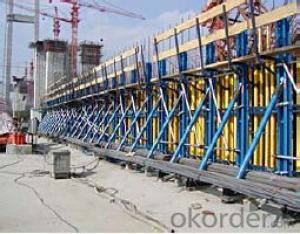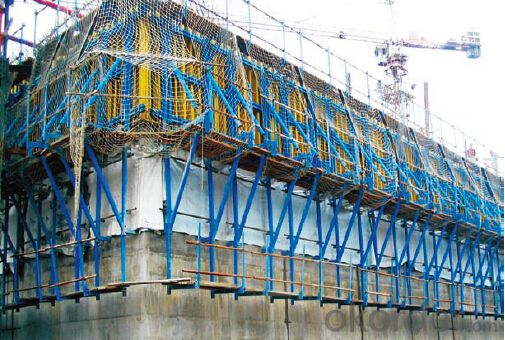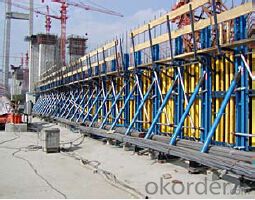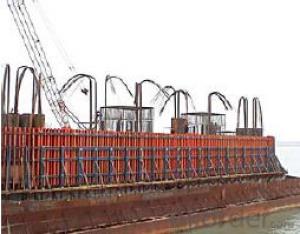Single-side climbing bracket SCB40 for formwork and scaffolding system
- Loading Port:
- Tianjin
- Payment Terms:
- TT OR LC
- Min Order Qty:
- 50 m²
- Supply Capability:
- 1000 m²/month
OKorder Service Pledge
OKorder Financial Service
You Might Also Like
Single-side Climbing Bracket SCB180:
With CNBM SCB 180 climbing systems, the loads from the fresh concrete pressure are
transferred through the brackets by means of V-strongbacks and compression braces into the
scaffold anchors.
Typical applications for the SCB 180 are dams, locks, cooling towers, pier heads, tunnels, and
bank vaults.
The formwork is simply tilted backwards when striking takes place. The 1.80 m wide bracket
requires only a minimum of space.
Characteristics:
◆ Economical and safe anchoring
The M30/D20 climbing cones have been designed especially for single-sided concreting using
SCB180 in dam construction, and to allow the transfer of high tensile and shear forces into the still
fresh, unreinforced concrete. Without wall-through tie-rods, finished concrete is perfect.
◆ Stable and cost-effective for high loads
generous bracket spacings allow large-area formwork units with optimal utilization of the bearing
capacity. This leads to extremely economical solutions.
◆ Simple and flexible planning
With SCB180 single-sided climbing formwork, circular structures can also be concreted without
undergoing any large planning process. Even use on inclined walls is feasible without any special
measures because additional concrete loads or lifting forces can be safely transferred into the
structure.
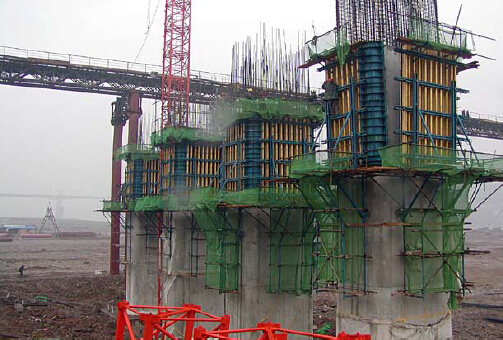
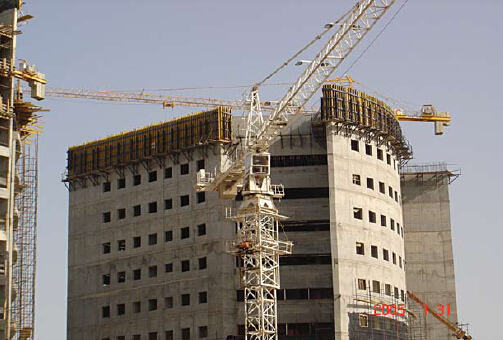
- Q: How is steel formwork supported during concrete pouring?
- Steel formwork is supported during concrete pouring through a system of props, beams, and scaffolding. Props are vertical supports that are strategically placed beneath the steel formwork to provide stability and prevent any sagging or collapsing under the weight of the wet concrete. These props are typically adjustable, allowing for precise positioning and leveling of the formwork. In addition to props, horizontal beams are used to provide further support to the steel formwork. These beams are usually placed at regular intervals and are connected to the props, creating a sturdy framework that can withstand the pressure exerted by the concrete. The beams also help distribute the load evenly across the formwork, ensuring that it remains balanced and secure. Scaffolding is another crucial component in supporting steel formwork during concrete pouring. It is erected around the formwork to provide a safe working platform for workers to access and maneuver the formwork. Scaffolding also assists in the installation and removal of the formwork, enabling efficient construction processes. Overall, the combination of props, beams, and scaffolding plays a vital role in supporting steel formwork during concrete pouring. This support system ensures that the formwork remains stable, allowing the concrete to be poured and cured accurately, resulting in a strong and durable structure.
- Q: Are there different sizes of steel formwork available?
- Yes, there are different sizes of steel formwork available.
- Q: Can steel formwork be used for both small and large concrete pours?
- Steel formwork is applicable for concrete pours of various sizes and dimensions. Its adaptability allows for easy adjustment and modification to accommodate diverse concrete structures. Its robustness and stability make it suitable for extensive pours that entail substantial weights and pressures. Moreover, the reusability of steel formwork renders it an economically viable choice for construction projects, regardless of their scale.
- Q: How does steel formwork handle concrete flowability and workability?
- Steel formwork is highly effective in handling concrete flowability and workability. Its smooth and rigid surface allows for easy movement and placement of concrete, ensuring a consistent and uniform flow during the pouring process. Additionally, steel formwork provides excellent support and stability, preventing any deformation or leakage of concrete. Its strength and durability enable it to withstand the pressure exerted by the concrete, ensuring that the formwork retains its shape and integrity throughout the entire curing period. Overall, steel formwork plays a crucial role in maintaining the desired flowability and workability of concrete, resulting in high-quality and structurally sound constructions.
- Q: Can steel formwork be used for theater construction projects?
- Yes, steel formwork can be used for theater construction projects. Steel formwork offers durability, strength, and flexibility, making it suitable for creating complex shapes and structures required in theater construction. It provides a solid framework for creating stages, seating areas, and other components of theater spaces. Additionally, steel formwork can be easily reused and adjusted to meet the specific design requirements of theater projects.
- Q: How does steel formwork affect the overall long-term performance of the structure?
- Steel formwork can have a significant impact on the overall long-term performance of a structure. One of the key advantages of using steel formwork is its durability. Steel is a strong and resilient material that can withstand heavy loads and extreme weather conditions, ensuring the longevity of the structure. When steel formwork is used, it provides a rigid and stable framework for pouring concrete. This results in a more accurate and precise construction process, which ultimately leads to a better quality and stronger structure. The use of steel formwork also allows for faster construction, as it can be easily assembled and disassembled, reducing the overall construction time. Furthermore, steel formwork provides a smooth and flat surface finish, which is crucial for the aesthetic appeal of the structure. The smooth surface reduces the need for additional finishing work, saving both time and money. Additionally, the use of steel formwork ensures that the concrete is properly supported and reinforced, preventing issues such as cracking, sagging, or deformation over time. Another advantage of using steel formwork is its reusability. Unlike traditional wooden formwork, steel formwork can be used multiple times, resulting in cost savings and reduced environmental impact. The durability and strength of steel formwork allow it to withstand the wear and tear of multiple uses, making it a more sustainable option. In summary, steel formwork positively affects the overall long-term performance of a structure by providing durability, strength, accuracy, and reusability. It ensures a high-quality construction process, resulting in a strong and aesthetically pleasing structure that can withstand the test of time.
- Q: Can steel formwork be used for foundation walls?
- Indeed, steel formwork proves to be a suitable choice for foundation walls. With its durability and strength, this material offers exceptional support for concrete during construction. It is versatile enough to be applied both horizontally and vertically, including for foundation walls. The benefits of steel formwork are numerous, encompassing a high load-bearing capacity, reusability, and effortless installation and removal. This formwork enables precise shaping of foundation walls, guaranteeing a seamless and consistent finish. Moreover, steel formwork's resistance to moisture and ability to endure harsh weather conditions make it a fitting option for foundation walls in diverse environments.
- Q: What are the different types of formwork bracing used in steel formwork?
- There are several different types of formwork bracing used in steel formwork, each providing unique features and benefits. Here are some of the most common types: 1. Adjustable Steel Bracing: This type of bracing consists of adjustable steel tubes or rods that can be easily extended or retracted to the desired length. It allows for quick and easy installation and adjustment, making it ideal for projects with varying formwork heights. 2. Cross Bracing: Cross bracing, as the name suggests, involves diagonal steel members that are placed to form an "X" shape between vertical supports. It provides lateral stability to the formwork system and helps prevent buckling or deformation. 3. Tie Rod Bracing: Tie rod bracing involves the use of threaded steel rods that are connected through formwork panels to provide additional strength and stability. It is commonly used in large-scale formwork systems where high loads need to be supported. 4. External Bracing: External bracing is often used in taller formwork structures to provide increased stability against wind forces. It involves installing steel members on the exterior side of the formwork system to resist lateral movement and maintain structural integrity. 5. Kickers: Kickers are diagonal bracing elements that are installed between formwork panels and the ground or a solid anchor point. They help transfer the lateral forces and prevent the formwork from tilting or collapsing. 6. Strut Bracing: Strut bracing involves the use of steel struts or props that are placed vertically between the formwork panels and the ground. It provides additional support to prevent horizontal movement and ensure the stability of the formwork system. 7. Flying Bracing: Flying bracing is used in situations where formwork needs to be supported from above, such as in bridge construction or overhead structures. It involves suspending bracing elements from overhead supports to provide stability and prevent formwork deformation. Each type of formwork bracing has its advantages and is chosen based on the specific requirements of the project, including the height and size of the formwork, expected loads, and site conditions. A combination of different bracing types may also be used to provide optimal stability and safety.
- Q: What are the considerations when designing steel formwork for slabs with openings?
- When designing steel formwork for slabs that have openings, it is crucial to take several important factors into consideration. These factors include: 1. Load-bearing capacity: The formwork needs to be able to support the weight of the concrete and any additional loads that may be applied during construction or usage. It should be designed to withstand these loads without experiencing excessive deflection or failure. 2. Durability: Steel formwork should be able to withstand the harsh conditions found on construction sites, including exposure to moisture, chemicals, and physical impact. The chosen material should be resistant to corrosion and have a high strength-to-weight ratio. 3. Flexibility and adjustability: Since slabs with openings often have irregular shapes and sizes, the formwork should be designed to be flexible and adjustable. This allows for easy customization and ensures a precise fit for the openings. 4. Support for reinforcement: The formwork should provide adequate support for the reinforcement bars or mesh used within the slab. It should be designed to accommodate the placement and spacing of these reinforcements, ensuring proper concrete cover and structural integrity. 5. Ease of assembly and disassembly: The formwork system should be designed for easy assembly and disassembly, as it will be used repeatedly for multiple slabs with openings. The components should be lightweight and easy to maneuver, allowing for efficient construction and reduced labor costs. 6. Safety: Safety is a top priority when designing steel formwork. The formwork should be designed to prevent accidents, such as slipping or collapsing, during assembly, concrete pouring, and removal. Adequate safety measures, such as guardrails and non-slip surfaces, should be incorporated into the design. 7. Cost-effectiveness: The design should aim to minimize material and labor costs while still ensuring the required strength and durability. Efficient use of materials and standardization of components can help reduce overall costs. 8. Compatibility with other construction systems: The formwork should be compatible with other construction systems, such as scaffolding or shoring, to ensure proper integration and coordination during the construction process. By considering these factors, designers can create steel formwork systems that are safe, durable, cost-effective, and efficient for slabs with openings.
- Q: What are the considerations when designing steel formwork for bridges?
- When designing steel formwork for bridges, there are several considerations to take into account. Firstly, the load capacity of the formwork must be determined, ensuring that it can support the weight of the wet concrete and any construction equipment. Additionally, the formwork should be designed to withstand the forces generated during the pouring and curing of the concrete, such as lateral pressure and vibration. The formwork system should also be easy to assemble, disassemble, and adjust to accommodate different bridge geometries and dimensions. It is important to consider the durability and corrosion resistance of the steel used in the formwork, as bridges are often exposed to harsh environmental conditions. Finally, the design should incorporate safety measures, such as guardrails and access platforms, to ensure the safety of workers during construction.
Send your message to us
Single-side climbing bracket SCB40 for formwork and scaffolding system
- Loading Port:
- Tianjin
- Payment Terms:
- TT OR LC
- Min Order Qty:
- 50 m²
- Supply Capability:
- 1000 m²/month
OKorder Service Pledge
OKorder Financial Service
Similar products
Hot products
Hot Searches

